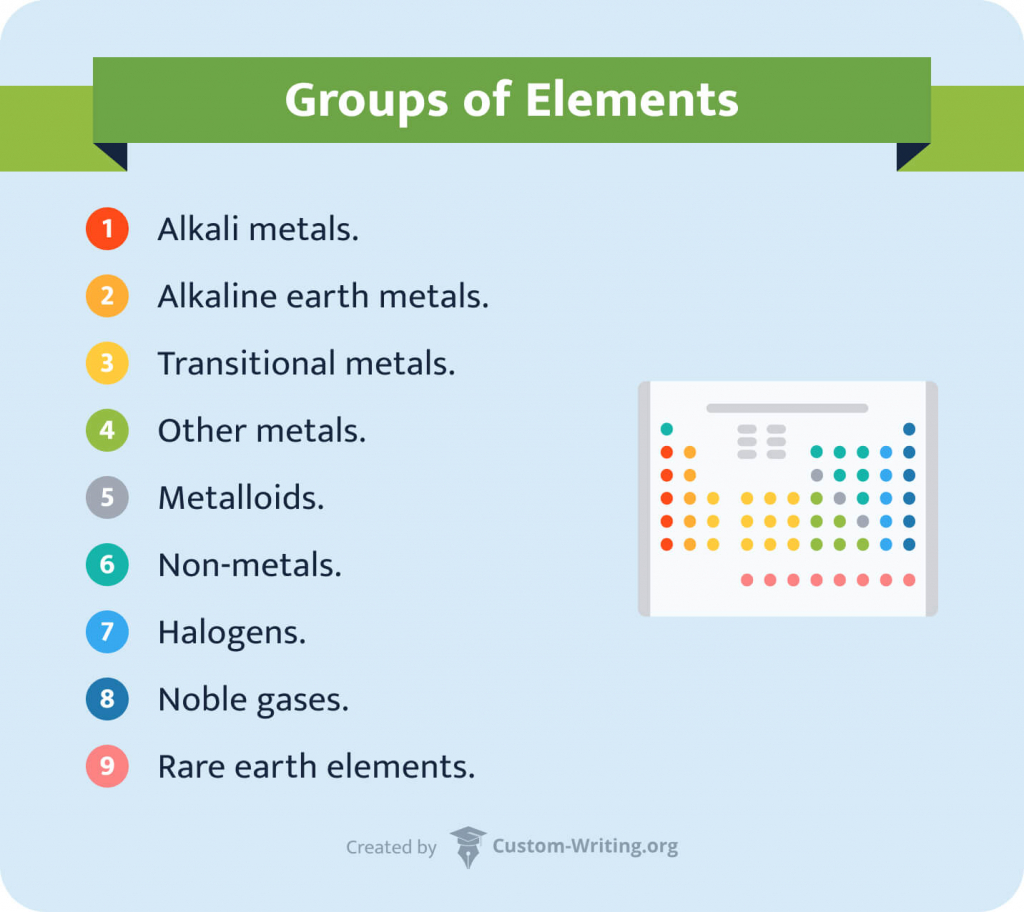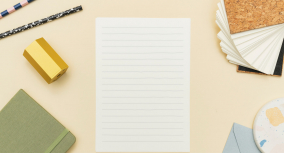Memorizing large chunks of data is challenging for most learners. To help our brain process and recollect them fast requires effective strategies. If you’re a chemistry student, you need to work with the periodic table often, and learning all the elements in order can be hard.

Fortunately, our custom writing team is here to help! This article will:
- clarify how to interpret the periodic table;
- describe practical memorization methods and tricks.
This information will be beneficial for everyone curious about memorization techniques, not just chemistry students.
⚛️ How to Read the Periodic Table
Did you know that Dmitri Mendeleev developed the first periodic table in 1869? He did it after noticing that specific elements shared similar characteristics. The periodic table is full of various repeating patterns. It enabled predicting the existence of some elements even before their discovery.
That’s why, before memorizing the periodic table, it’s recommended to comprehend its organization. Doing so will let you interpret it accurately.
Do you need a quick reminder of the periodic table basics? Read the information below.
Elements & Their Properties
So, what is a chemical element? Well, it’s a substance that comprises atoms with the same atomic number. It cannot be split into simpler substances using typical methods. Each element in the table has a square containing all necessary details about it. Let’s take a closer look:
- Name of the element. All elements have a unique name. It typically comes from Latin and is related to the element in some way (such as the place where it was discovered.)
- The official chemical symbol. Each element has a symbol consisting of one or two letters from the element’s Latin name. The first letter is always capitalized.
- The atomic number. This number demonstrates how many protons (and electrons) an atom includes. Note that an atom’s radius gets bigger as you go down the column on the periodic table.
- Period. The period (or the row) shows the energy level of the electrons in an atom. In total, the table has 7 periods. Each period, except the first one, begins with a metal and ends with a noble gas.
Groups of Elements
Elements with similar properties are placed together and are colored differently in the periodic table. These groups are also called families. According to them, chemicals can be categorized into metals, nonmetals, metalloids, halogens, noble gases, and rare earth elements.
- Metals. Metals are malleable, ductile, and are good conductors of heat and electricity.
- Nonmetals. Nonmetals are usually poor conductors of heat and electricity. They are not malleable or ductile.
- Metalloids. These elements combine the attributes of metals and nonmetals. Under specific circumstances, some of them can conduct electricity.
- Halogens. Halogens are highly reactive and toxic. They form salts by combining with metals. You can find them in group 17.
- Noble gases. Noble gases are unreactive and stable. They are colorless, have no smell, and are situated in group 18 on the periodic table.
- Rare earth elements. These elements are called rare earths because of their scarcity. They are divided into light and heavy ones and can be found in the row below the table’s main body.

🎓 How to Learn the Periodic Table of Elements: Ultimate Guide
For an unprepared student, the periodic table is full of confusing symbols and numbers. It may even look terrifying at first glance! You don’t have to worry—our tips will help you quickly memorize all 118 elements.
Top 5 Mnemonic Devices
You may know that it’s easier to remember information when it’s interconnected in some way. For instance, most people quickly learn songs or poems that rhyme. However, things are different with chemical elements: their names are unrelated to each other, and their order is not apparent. Is there anything that can help you memorize them?
Well, we suggest using mnemonic devices to remember this kind of information. They can take various forms, and you’re free to choose them depending on your preferences. For instance, flashcards, acronyms, and simple poems are all forms of mnemonic devices.
When it comes to the periodic table of elements, we recommend these 5 effective techniques:
- Phrases. Chemistry mnemonic phrases consist of words made using the elements’ names. It’s best to create a mnemonic that you find funny or familiar. Here’s an example: Harry Helps Little Betty Brown Crack Nuts On Friday Nights. The first letters here refer to the first 10 elements on the periodic table.
- Acronyms and acrostics. This technique refers to creating words containing the first letters of the elements’ names. The words can be nonsensical as long as they are easy to remember. For instance, the word HHeLiBeBCNOFN has no meaning, but it contains the symbols of the first 10 elements. You can also create a phrase related to that word to help you remember it.
- The element songs. One of the best ways to memorize chemical elements is by listening to songs. You may find it surprising, but there are plenty of fun element songs you can find online. Choose one and play it on repeat while you get ready in the morning or on your way to school.
- Mental imagery. Some people are more inclined to memorize information if they have a visual in their mind. Are you one of them? In that case, watching YouTube videos on “How to Memorize” may be helpful, as they use pictures and colors to introduce information. Creating your own visual story or linking an image to each element may also be useful.
- Create your own quizzes. It may seem weird to work on periodic table questions yourself, but you may be surprised by how efficient this method can be. While preparing the questions, you’ll do more research on the elements and structure key information. Quizzing yourself can help you see what topics you need to brush up on and pay attention to.
Repetition Techniques for Memorizing
Repeatedly going over the elements is key to memorizing them correctly. Though repetition may seem dull and unhelpful, studies confirm that this type of learning facilitates remembering and retrieving information from your memory. So, why not leverage it?
Here are the strategies that will make the process simpler and more exciting:
- Break elements into groups of five. By categorizing the elements into groups of five, you end up with just 23 groups to learn instead of trying to memorize all 118 elements individually. Breaking them into small, digestible sets is a practical strategy to learn the periodic table.
- Space out your learning sessions. Instead of cramming all the information at once, split your study session into a few smaller chunks. For instance, you can learn the periodic table for one hour, take a 15-minute break, and then go back to study for another hour. This method will allow your brain to recharge and absorb more.
- Recite the element names out loud. Saying things out loud is better for memorization than repeating them in your head. It encourages you to concentrate on the task and facilitates active learning.
- Don’t be scared to overlearn. When you feel you’ve memorized the list of elements well enough and can successfully recite it, try doing it several times. Studies show that overlearning strengthens your knowledge and positively affects how fast you can retrieve information in the future.
Learning the Periodic Table Using Visual Memory
Do you prefer memorizing information visually? If so, you’ll find this part especially engaging! Here is a list of pointers that you might want to include in your study routine to learn the periodic table (or anything else) effectively:
- Print the table leaving blank spaces to fill in. Recreating the periodic table visually by yourself is a splendid way to practice.
- Use flashcards. Flashcards are a brilliant method to memorize large portions of content. Even while making the cards, you’re already learning the elements’ names. You can also include the atomic number on the card.
- Use colors. Color is an essential element in visualization. By relating various colors to a specific element group, you help your brain sort information and create an image in your mind. This method can make the memorization process much quicker and more efficient.
Best Apps to Help You Learn the Elements
Since phones have become a fundamental part of our lives, using apps to learn and memorize new information can be a great idea. Here are some of our favorites that we suggest you try out:
- Periodic Table
This app will provide you with information on every element of the periodic table. When you click on the chemical element, you learn its name in Latin and English, when it was discovered, and by whom. The app has a modern, intuitive design. Additionally, it provides links to other sources and saves your search history. - Periodic Table by Royal Society of Chemistry
This app introduces the user to each element and includes content such as videos, images, and podcasts. You just need to click on each chemical to learn more about it. The application also allows the user to see patterns and trends that make up the table. It’s available for both mobile and tablet devices. - The Elements by Theodore Gray
This paid application not only provides information but also dives into the history of each element. It even describes the effect each of them has on the Universe as a whole. Besides, it has awesome illustrations. - NovaElements
This free app from PBS is perfect for children. Aside from an interactive periodic table, it has games and beautifully produced videos. Another cool feature is models of atoms that you can build yourself.
👍 Bonus Memorization Techniques for Any Subject
Finally, we would like to share our favorite tips for remembering large chunks of information, be it chemistry or any other subject.
- Link it to what you already know. For example, you may connect the date of a historic event to your phone number with the same digits.
- Write out what you’ve learned. Handwriting your notes is an excellent way to remember new information without much effort. When you’re writing by hand, your brain activity gets boosted, which enhances your memory.
- Employ metaphors and analogies. Comparing new things to familiar ones immediately anchors concepts in your mind. Fun visual analogies are especially helpful in this regard.
- Use all five senses. Don’t settle for what you believe your learning style is. It’s been proven that students benefit from various kinds of instructions: the more variety, the better. We recommend you look at visuals, read aloud, and interact with things to remember them better.
- Mix multiple subjects. If you need to memorize information for several subjects, try alternating between them. Spend 30 minutes learning historical dates, then turn to the periodic table or a new vocabulary. It’s an excellent strategy that is much more effective than spending hours on just one subject. Try it out!
We hope that after reading our article, you don’t feel intimidated by the periodic table anymore and can now memorize it quickly while having a little fun. Try implementing our tips into your study routine and see what works best for you!
🔍 References
- Element Mnemonic Device – Periodic Table Symbols: ThoughtCo
- How to Memorize the Periodic Table: Science Notes
- Atomic Numbers: Angelo State University
- How to Memorize the Periodic Table: Sciencing
- Periodic Table: Britannica
- Science-Backed Memory Tips and Recall Techniques: University of St.Augustine for Health Sciences
- Memory Improvement Techniques – Start Here: Mind Tools

![How to Deal with FOMO in College [+Turn It into JOMO]](https://custom-writing.org/blog/wp-content/uploads/2022/10/smiling-african-student-pointing-with-pencil-laptop-screen-concentrated-blonde-woman-glasses-propping-chin-with-hand-while-working-with-computer-office-1-284x153.jpg)

![How to Get Perfect Letters of Recommendation for College [Guide]](https://custom-writing.org/blog/wp-content/uploads/2022/08/NA_SEP._14-284x153.jpg)

![How to Search the Web Effectively [For Students]](https://custom-writing.org/blog/wp-content/uploads/2022/08/hand-touching-with-search-icon-search-engine-optimisation-seo-concept-find-information-by-internet-connection-1-284x153.jpg)
![Top 25 Gadgets You Need to Study Smarter [from $20]](https://custom-writing.org/blog/wp-content/uploads/2022/06/sad-female-workaholic-keeps-hands-chin-busy-making-project-work-studies-papers-wears-elegant-white-shirt-sits-desktop-unknown-people-stretch-hands-with-notes-alarm-clock-smartphone-1-284x153.jpg)




